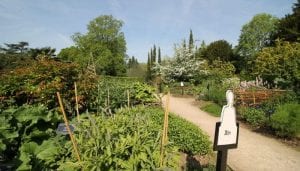
The Western Herb Garden has been designed to reflect the origins of traditional western herbal medicine. Its concept is to mirror a Renaissance physic garden, like that at Padua, Italy. The display shows plants that are used to treat specific parts of the body, such as the lungs, heart, and intestines. The circular garden is surrounded by a beech hedge and is divided into four by two crossing paths. These four beds are further divided to form thirteen ‘use category’ displays for treating: skin, respiration, muscles & skeletal, glandular, reproduction, infestations infections & immune system, heart & circulation, respiration, liver, digestion, urinary, nervous and ears, nose, eyes & throat. The plants are grown primarily of European origin, for example sage (Salvia officinalis) and rosemary (Rosmarinus officinalis) together with a few species from North America, such as black cohosh (Cimicifuga racemosa) and pokewort (Phytolacca americana). The display is used as a teaching resource for the gardens adult education programme and in support of teaching in the Chinese medicinal herb garden.
Economically important food, spice and other ‘useful’ plants are grown throughout the garden. Examples of cereals including wheat (Triticum aestivum), maize (Zea mays) and sorghum (Sorghum nigrum) are grown as part of the grass family (Poaceae) section in the Angiosperm Phylogeny display. Durum wheat (Triticum durum), oriental oats (Avena orientalis) and winter barley (Hordeum distichon) are grown to represent agricultural crops in the Mediterranean basin display. Familiar plants are grown so that visitors and school groups can learn which plants provide many of our familiar foodstuffs, including potatoes (Solanum tuberosum), tomatoes (Lycopersicon esculentum),and hops (Humulus lupulus).
In the glasshouse tender, useful plants are grown including those that provide many ‘commodity crops’ such as sugar cane (Saccharum officinarum), tea (Camellia sinensis), and coffee (Coffea arabica). The tropical zone provides perfect conditions for the cultivation of tropical food plants including, cocoa (Theobroma cacao), banana (Musa acuminata ‘Dwarf Cavendish’) and cassava (Manihot esculenta). Spice plants are also grown, including cinnamon (Cinnamomum zeylanicum), pepper (Piper nigrum) and cardamom (Elettaria cardamomum). Medicinal plants grown in the tropical zone include Madagascan periwinkle (Catharanthus roseus), which is a source of two alkaloids, vincristine, and vinblastine, two important drugs in the treatment of leukaemia, sarcoma, Hodgkin’s disease and other lymphomas. Most notably the use of vincristine in combination with other drugs is successfully used in treating childhood acute lymphoblastic leukaemia.

Further ‘useful’ plants are grown throughout the garden, but are principally represented in other core collections. For instance ‘useful’ plants from South Africa, including wild dagga (Leonotis leonurus), wild garlic (Tulbaghia violacea) and T. simmleri, and arum (Zantedeschia aethiopica) are displayed in the Mediterranean Climate Regions display of plants from the South Western tip of South Africa, while stangeria (Stangeria eriopus), red paint brush (Scadoxus puniceus) and bush lily (Clivia miniata) are displayed as part of the Evolution of Land Plants and Adaptation to the Environment Displays. All are important traditional South African medicinal plants, which are still widely used by many local people. The non-sustainable use of these plants and other medicinal plants is cause for concern as increasingly wild populations are targeted to support domestic and international demand.

